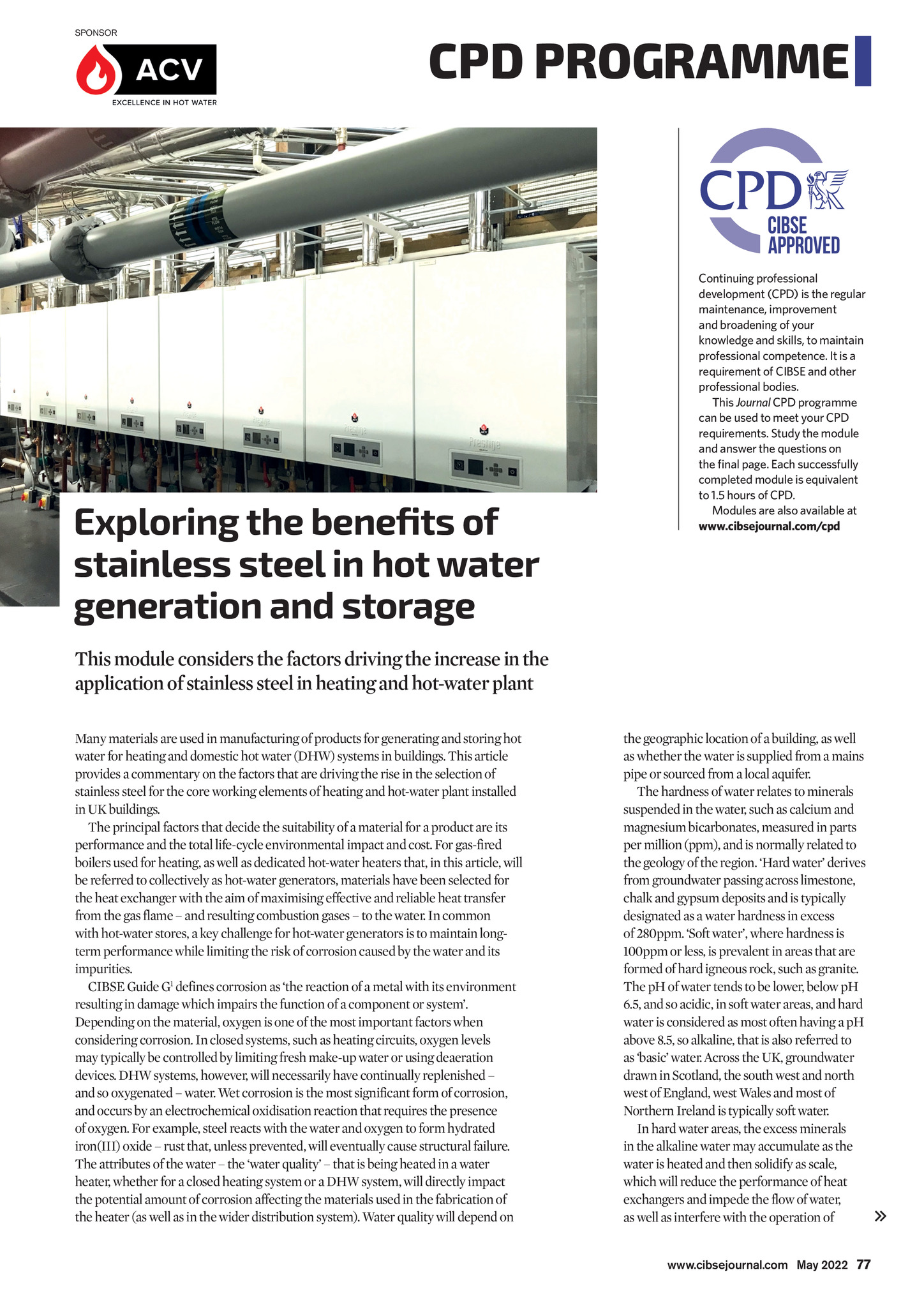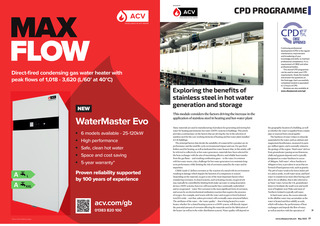


SPONSOR CPD PROGRAMME Exploring the benefits of stainless steel in hot water generation and storage Continuing professional development (CPD) is the regular maintenance, improvement and broadening of your knowledge and skills, to maintain professional competence. It is a requirement of CIBSE and other professional bodies. This Journal CPD programme can be used to meet your CPD requirements. Study the module and answer the questions on the final page. Each successfully completed module is equivalent to 1.5 hours of CPD. Modules are also available at www.cibsejournal.com/cpd This module considers the factors driving the increase in the application of stainless steel in heating and hot-water plant Many materials are used in manufacturing of products for generating and storing hot water for heating and domestic hot water (DHW) systems in buildings. This article provides a commentary on the factors that are driving the rise in the selection of stainless steel for the core working elements of heating and hot-water plant installed in UK buildings. The principal factors that decide the suitability of a material for a product are its performance and the total life-cycle environmental impact and cost. For gas-fired boilers used for heating, as well as dedicated hot-water heaters that, in this article, will be referred to collectively as hot-water generators, materials have been selected for the heat exchanger with the aim of maximising effective and reliable heat transfer from the gas flame and resulting combustion gases to the water. In common with hot-water stores, a key challenge for hot-water generators is to maintain longterm performance while limiting the risk of corrosion caused by the water and its impurities. CIBSE Guide G1 defines corrosion as the reaction of a metal with its environment resulting in damage which impairs the function of a component or system. Depending on the material, oxygen is one of the most important factors when considering corrosion. In closed systems, such as heating circuits, oxygen levels may typically be controlled by limiting fresh make-up water or using deaeration devices. DHW systems, however, will necessarily have continually replenished and so oxygenated water. Wet corrosion is the most significant form of corrosion, and occurs by an electrochemical oxidisation reaction that requires the presence of oxygen. For example, steel reacts with the water and oxygen to form hydrated iron(III) oxide rust that, unless prevented, will eventually cause structural failure. The attributes of the water the water quality that is being heated in a water heater, whether for a closed heating system or a DHW system, will directly impact the potential amount of corrosion affecting the materials used in the fabrication of the heater (as well as in the wider distribution system). Water quality will depend on the geographic location of a building, as well as whether the water is supplied from a mains pipe or sourced from a local aquifer. The hardness of water relates to minerals suspended in the water, such as calcium and magnesium bicarbonates, measured in parts per million (ppm), and is normally related to the geology of the region. Hard water derives from groundwater passing across limestone, chalk and gypsum deposits and is typically designated as a water hardness in excess of 280ppm. Soft water, where hardness is 100ppm or less, is prevalent in areas that are formed of hard igneous rock, such as granite. The pH of water tends to be lower, below pH 6.5, and so acidic, in soft water areas, and hard water is considered as most often having a pH above 8.5, so alkaline, that is also referred to as basic water. Across the UK, groundwater drawn in Scotland, the south west and north west of England, west Wales and most of Northern Ireland is typically soft water. In hard water areas, the excess minerals in the alkaline water may accumulate as the water is heated and then solidify as scale, which will reduce the performance of heat exchangers and impede the flow of water, as well as interfere with the operation of www.cibsejournal.com May 2022 77 CIBSE May 22 pp77-80 CPD 195.indd 77 22/04/2022 16:15